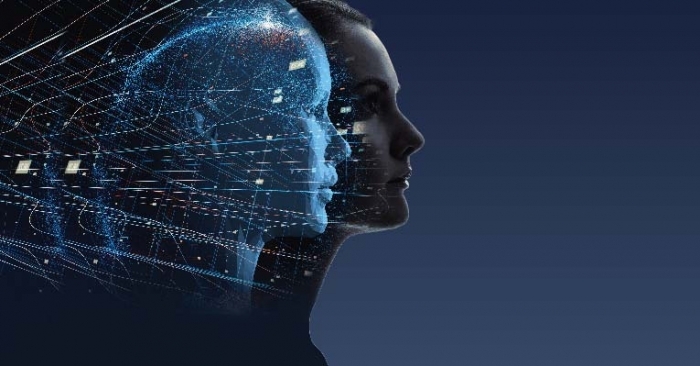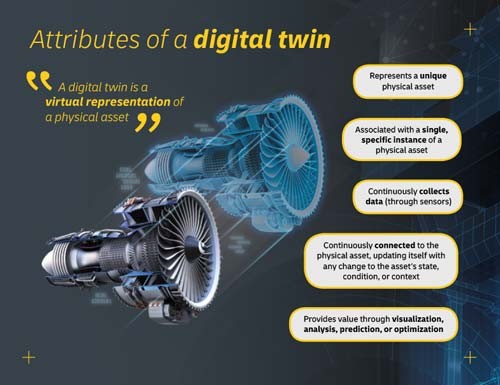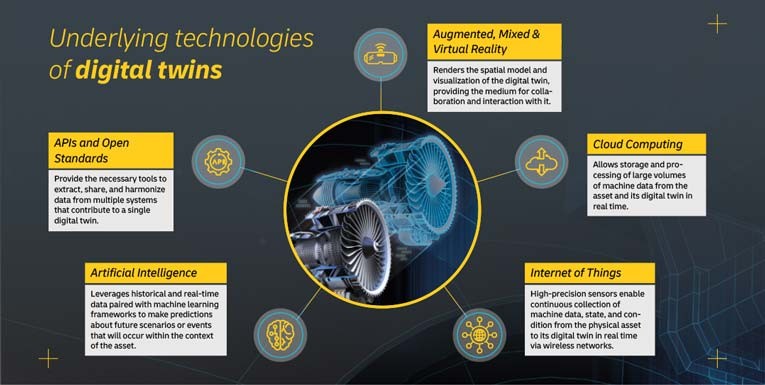FROM MAGAZINE: Digital twins for logistics
How do you operate, maintain, or repair systems when you aren’t in their physical proximity? That was the challenge for NASA when it had to monitor its rockets and vehicles on space missions. So it created mirrored systems or digital twins, still on earth that allowed engineers and astronauts to determine how they could control space mission

How do you operate, maintain, or repair systems when you aren’t in their physical proximity? That was the challenge for NASA when it had to monitor its rockets and vehicles on space missions. So it created mirrored systems or digital twins, still on earth that allowed engineers and astronauts to determine how they could control space mission vehicles. The concept of digital twin helps to control Chandrayaan-2, India’s lunar mission. A digital twin can create huge value in logistics and provide greater insight into and visibility of the current and future state of logistics.
Reji John
It was in the late 1990s that Michael Grieves began thinking the idea of the digital twin. Grieves was then pursuing his executive management doctorate programme at Case Western Reserve University in Cleveland, Ohio. However, the term he used then for the concept was “Doubleganger”. In 2002 Grieves introduced the concept as part of his product lifecycle management (PLM) research at the University of Michigan. The slide that contained the revolutionary idea showed a simple graphic with the sober title “Conceptual Ideal for PLM”.
While the term changed over and over again in the years to follow, this graphic already contained everything that still makes up the digital twin: a virtual image that contains all the information of a physical product and reflects it throughout the entire product lifecycle – an idea so visionary that it could not be achieved for many years.
While Grieves was toying with the idea years ago and was not in a position to implement a comprehensive digital twin, he was firmly convinced that the computer would be powerful enough someday to bring his ideas to life. Today, machine intelligence and connectivity to the cloud allows us an unprecedented potential for large-scale implementation of digital twin technology for companies in a variety of industries.
Digital twins are today coming of age. Fuelled by the confluence of progress in the internet of things, big data, cloud computing, open APIs, artificial intelligence, and virtual reality, once-static digital models and simulations can now truly come alive in real time to help predict future situations, the state of physical things, and even the world around us.

Source: DHL Trend Research
Today the evolution of sensors and network technologies enables us to link previously offline physical assets to digital models. In this way, changes experienced by the physical object are reflected in the digital model, and insights derived from the model allow decisions to be made about the physical object, which can also be controlled with unprecedented precision.
Digital twins can ultimately represent any physical thing, from nanomaterials all the way to entire cities. Even human beings and their behaviours have been modelled by digital twins in some cases. Organisations in multiple sectors are developing, testing, and utilising digital twins within their operations. The following examples show how digital twins have the potential to solve a broad range of business challenges and to unlock many different sources of value.
The central goal of using digital twins today is to accurately predict and prevent problems before they occur and to plan for the future efficiently.
Digital twins enable logistics providers and other supply chain enterprises to offer the increased transparency partners and consumers demand. And in doing so, companies earn one of the most valuable, hard-to-come-by commodities in business: trust.
By making the production and distribution of goods more transparent with digital twins, logistics providers and other supply chain organisations can earn greater trust and respect from partners and consumers – and forge long-lasting, successful relationships that result in undeniable business outcomes.
How will digital twins transform the logistics industry in general? “Looking ahead, we believe that the adoption of digital twins across industries will drive better decision making in the physical world. That, in turn, will drive significant changes in the operation of supply chains and logistics processes,” wrote Matthias Heutger, senior vice president, global head of innovation & commercial development and Markus Kueckelhaus, vice president, innovation & trend research at DHL in a recent report by DHL on the impact of digital twins on the logistics industry.
In the logistics industry itself, digital twins will extend the benefits of IoT already being applied today. They will bring deeper insight into the planning, design, operation, and optimisation of supply chains, from individual assets and shipments to entire global supply networks. We think there has never been a more exciting time for industries and logisticians to work together to leverage the full potential of digital twins,” said Heutger and Kueckelhaus in the report.

Source: DHL Trend Research
The DHL trend report acknowledges the fact that bringing these and other technologies together into a full digital twin implementation is a complex and challenging endeavour. The cost-sensitive nature of many logistics activities, says the report, may explain why few companies have so far been willing to make the necessary investments. It is clear that the exploration of potential use cases for digital twins across the logistics space is now worthwhile. As costs fall and confidence in technology grows, the business case for some or all of the approaches described in the report (and summarised below) may become compelling within the coming years.
Packaging and container digital twins
The overwhelming majority of products that move through logistics networks do so in some form of protective enclosure. The industry employs large quantities of single-use packaging together with fleets of dedicated or general-purpose reusable containers. Designing, monitoring, and managing packaging and containers creates a number of challenges for the industry. The growth of e-commerce, for example, is driving up demand, seasonal volatility, and packaging variety. This, in turn, produces significant waste and reduces operational efficiency through poor volume utilisation.
The application of material digital twins could aid the development of stronger, lighter, more environmentally friendly packaging materials. In efforts to improve sustainability, companies are exploring the application of a range of new materials including compostable plastics and materials with a high percentage of post-consumer recycled content.
Digital twins of shipments
Incorporating the contents of a package or container into its digital twin is the next logical step. If a digital twin of an item to be shipped has already been created, data describing its geometry can be obtained from this pre-existing source, for example. Alternatively, the item data can be generated when the shipment is prepared, using 3D scanning and the same computer vision technologies mentioned in the previous section. Combining product and packaging data could help companies improve efficiency, for example by automating packaging selection and container packing strategies to optimise utilisation and product protection.
A shipment digital twin would act as a repository for the data collected by these sensors. Digital twin technologies could also allow this data to be used in new ways. A model that includes the thermal insulation and shock-absorbing characteristics of the packaging, for example, could allow conditions inside the product to be extrapolated from data collected by external sensors.
Digital twins of warehouses and distribution centres
Digital twins could have a significant impact on the design, operation, and optimisation of logistics infrastructure such as warehouses, distribution centres, and cross-dock facilities. These digital twins could combine a 3D model of the facility itself with IoT data collected in connected warehouse platforms, as well as inventory and operational data including the size, quantity, location, and demand characteristics of every item.
Warehouse digital twins can support the design and layout of new facilities, allowing companies to optimise space utilisation and simulate the movement of products, personnel, and material handling equipment.
Digital twins of logistics infrastructure
Warehouses and distribution centres make up just a fraction of all logistics infrastructure. The flow of goods from source destination depends on the orchestration of multiple elements including ships, trucks and aircraft, order and information systems, and, above all, people. This complex, multi-stakeholder environment can be seen most clearly at major global logistics hubs such as cargo airports and container ports. At these facilities today, the challenge of efficient operation is exacerbated by imperfect systems for information exchange, with many participants reliant on offline processes that can be subject to errors and delays.
Digital twins of global logistics network
In logistics, the ultimate digital twin would be a model of an entire network including not just logistics assets but also oceans, railway lines, highways, streets, and customer homes and workplaces. The idea of such an all-encompassing twin even like the one depicted earlier in this chapter is largely an aspiration for the logistics industry for now. However, it is important to envisage where the full realisation of logistics digital twins may lead.
For digital twins and their physical counterparts to work together optimally, there is an accelerating need for logistics professionals to improve responsiveness, service quality, availability, and delivery accuracy to ensure the thing performs in optimal harmony with its intended design and performance
“Digital twins offer unparalleled capabilities to track, monitor, and diagnose assets. They will change traditional supply chains, with a range of options to facilitate data-driven decision making and collaboration, streamlined business processes, and new business models. We are keen to work with our customers and partners to jointly explore applications in our industry,” said Heutger.
“The market for digital twins is expected to grow more than 38 percent each year, passing the $26 billion mark by 2025,” he added.
This story was originally published in Indian Transport & Logistics News' July - August 2019 issue.

Reji John
Editor at STAT Publishing Group since 2013, I lead a small team of reporters in chasing stories about cargo flows from A to Z—by air, sea, road, and rail. If it moves, we track it. Got a compelling lead? Reach me at reji@statpublishinggroup.com (cargo only, please)


